 |
||
|
||
| ||
Talks about the Intel Pentium M processors with attractive power consumption and relatively low heat dissipation offering good performance have been running for a long time already. They often end with one wish: "If we could just install this CPU into a regular desktop computer!" However, this wish is without foundation, it's based solely on emotions: "I've got a notebook with Pentium M — it's very fast!" Yep, it's fast. It's fast for a notebook. But can we compare performance of a notebook and a desktop directly? In the first case we compare the performance with our previous impressions produced by other notebooks, not by a desktop... So, the problem of correct comparison between Pentium M and desktop CPUs is rather sharp, it certainly must have been solved. Either to make sure that a hypothetic PC with Pentium M inside is really very attractive, or to shatter this myth. Fortunately, some manufacturers released products that allow a correct performance comparison between Pentium M and regular CPUs. For example, AOpen and DFI launched desktop motherboards based on the Intel 855M mobile chipset (one of them, the DFI mobo, takes part in our tests) and ASUS surprised the world with... an adapter to install a mobile processor into desktop motherboards for Socket 478! But there is a fly in the latter ointment: as a processor must be supported by BIOS just to start up correctly, only ASUS motherboards can work with this adapter, their BIOS supporting Pentium M. Here is a list of such motherboards:
This adapter won't work with products from other manufacturers (even with ASUS motherboards that are not included in this list). Even if a miracle happens, no one knows how a CPU will be detected and whether it will work correctly (most likely answers to these questions are: incorrectly, badly). However, our attempts to start up a system with an adapter and a couple of Socket 478 motherboards from other manufacturers ended in a failure: the system booted (fans on a video card and a CPU cooler rotated, even the CPU got warm), but the screen remained pitch black. But let's return to our mobile desktop processors. Our main task in this test was simple: on the one hand, to compare the efficiency of various cores at the same clock (that is roughly speaking, to see how many performance units "in terms of MHz" provide processors of various architectures); on the other hand, to estimate (according to test results) the prospects of a hypothetical "mobile core from Intel on a desktop". In other words, to try and forecast the development of affairs, if Intel suddenly decides to give up NetBurst and create a desktop processor based on the same core as in Pentium M. It's high time to proceed to our tests... Testbed configurations
As you can see, the "zoo" is rather large. However, it's rather easy to come to know it, as only two large groups take part in the tests. They can be referred to as "AGP group" and "PCI Express group". The first group, AGP:
Thus, AGP was conditioned by the motherboard for our contenders (Pentium M) that supports this very graphics bus. The same applies to the second group that uses a PCI Express video card — firstly, because our ASUS motherboard, which supports the Socket 479 —> Socket 478 adapter, is equipped with this very graphics bus; secondly, why not install a more powerful video card on the testbed? PCI Express group:
We shall publish the reviews of some of these motherboards (especially of the interesting product from DFI) a tad later (watch the announcements in the Platform section). As for now, have a look at "the coming of Pentium M to desktop" in our test lab. 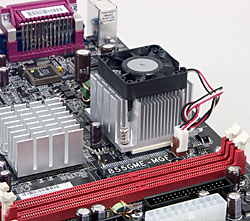 Socket with an installed cooler, DFI 855GME-MGF. 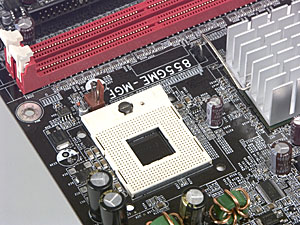 Socket 479. You will hardly mistake it for Socket 478: the socket is latched with a screwdriver instead of a usual lever. 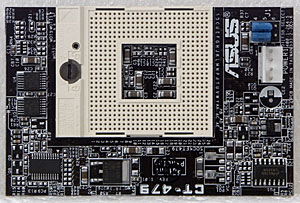 Socket 479 —> 478 adapter, ASUS CT-479 CPU Upgrade Kit, front view. These two jumpers set the FSB clock — 400 MHz or 533 MHz. The adapter does not have any other controls. 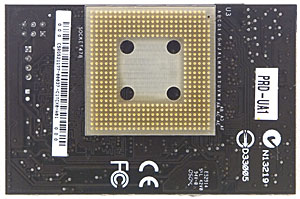 Socket 479 —> 478 adapter, ASUS CT-479 CPU Upgrade Kit, rear view. 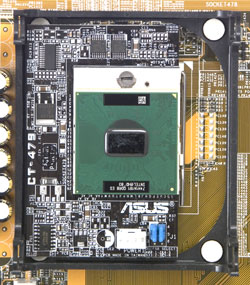 The adapter with a processor installed into Socket 478 on a motherboard. 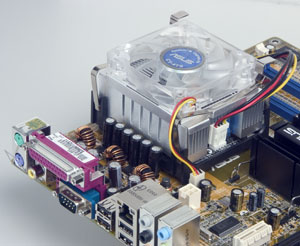 The same components with an installed cooler (it's a special cooler that comes shipped with the bundle of this adapter) The choice of processors is based on quite an evident principle (as far as possible): their clock should be maximum close to the clock of the top Pentium M. The only exception is Pentium 4: it would be evidently outperformed by all equally-clocked competitors, because higher core clocks are the main advantage of this CPU as well as NetBurst architecture as such. That's why we chose Pentium 4 so that its performance is approximately on the level with Pentium M 770. Of course, at an average that is in all the tests. Fortunately, it's no problem to calculate an average score using Excel GEOMEAN. I emphasize that the average score for Pentium 4 2.8E (in the AGP group) and Pentium 4 540J (in the PCI-E group) is indeed very close to the results of Pentium M 770 (for each group). What concerns "the relative efficiency in terms of MHz", this parameter is of no interest in case of Pentium 4 for the above reasons. Test resultsRemember that diagrams with all test results (61 items!) are published on a separate page — without comments, just as is. The article provides only summary diagrams that calculate the results of entire test groups into average scores. This approach appeases curiosity of the most inquisitive readers, who are against cutting down the number of test results published in our articles, and still makes the article less motley and graphics-intense. What concerns our comments, real professionals (who are interested in details) are expected to need none of them. SPECapc for 3ds max 6 (3ds max 7.0)The "old" platform represented by Athlon XP and Pentium 4 / Socket 478 looks the least convincing. Pentium M is quite good — it manages to outperform Pentium 4 540 3.2 GHz on the most progressive dual channel chipset with DDR2 (i955) even on a mobile platform. Pentium M demonstrates even higher results (by 8% better at an average) on a desktop platform (i915). However, the first place is still taken by Athlon 64, it outscores the best result of Pentium M by 6%, while its core clock is just 3% higher (2.2 GHz versus 2.13). Thus, Athlon 64 turns out generally more efficient than Pentium M. By the way, don't forget the fact that L2 Cache in Pentium M is twice as large. SPECapc for Maya 6 (Maya 6.5)Pentium M 770 on a desktop platform demonstrated the best result in this test. The weakest processor is the old Athlon XP 3000+, though its clock is even a tad higher than in the top mobile processor from Intel (2167 MHz). However, its cache is four times as smaller (!), perhaps that's the main reason. A dual channel chipset together with DDR400 (i915) is obviously more preferable to Pentium M than the native mobile i855M — performance gain of the mobile processor on a desktop platform reaches 12%. Which is only natural: even with "just" 533 MHz FSB, the single-channel DDR333 (that's the mode offered by the i855M) cannot supply all CPU wants in terms of memory access times. Lightwave 8.2, renderingQuite a motley picture, but the majority of processors demonstrate similar results, there is only one outsider — Athlon XP 3000+. Note that the Pentium M results on the mobile and desktop platforms are approximately the same. It means that the speed of memory operations is practically irrelevant for Lightwave. SPECapc for SolidWorks 2003Pentium M on the mobile platform goes approximately on a par with Pentium 4 2.8E and Athlon XP 3000+, on the desktop platform — approximately on a par with Pentium 4 540J (3.2 GHz). The fastest processor is Athlon 64 3700+ in both hypostases, as in case of 3ds max 7. Adobe Photoshop CS (8)The best result is demonstrated by Pentium 4 540 on the new platform with DDR2, the worst result belongs to the old Athlon XP 3000+. The results of other processors are approximately in the same range. The relatively small gap between the i915 and the i855 can most likely be explained by the fact that 2MB Cache in Pentium M is quite sufficient for Photoshop to make up for the slow memory operations. But that's only within the functions we examine here... Adobe Acrobat 6.0Quite an even line, but we still have leaders — Pentium M and Athlon 64. All-purpose data compression (archiving)It's for the second time already that the transition from a mobile platform to a desktop one adds 400 MHz to Pentium M "in Pentium 4 equivalent": while its performance on the i855 is similar to Pentium 4 2.8 GHz, on the i915 it gets on a par with Pentium 4 540 at 3.2 GHz. However, Athlon 64 is still faster, the gain is larger than could be expected from its clock advantage over Pentium M. Multimedia lossy compression (MP3/MPEG2-4)We can see again that sometimes a large cache voids the RAM performance advantages of some platforms: Pentium M results on the i855 and i915 are practically identical. But it doesn't mean that they are bad. On the contrary, the only processor that outperforms Pentium M 770 is Pentium 4 540. CPU RightMark 2004BQuite symptomatic: the results of Pentium M 770 and Athlon 64 3700+ match both times. Advantages of both Pentium 4 processors in this test are undeniable. And we know for sure about the reasons: only these processors support Hyper-Threading that allows to emulate two CPUs with only one physical core. 3D games and graphics visualization
|
AGP group demonstrates evident insufficiency of video card's performance, while PCI Express (ATI Radeon X800) shows CPU dependence. Well, we are quite used to Pentium 4 bringing up the rear in games, but Pentium M is good news — it nearly catches up with Athlon 64. Considering that the latter has a higher clock, we can assume that Pentium M would have caught up with it under equal conditions.
The situation is absolutely the same...
Painkiller dislikes all Intel processors, no exceptions. Though it doesn't favour the processor on the AMD K7 core (Athlon XP 3000+) either. So it would be more appropriate to speak of sympathies to the certain K8 core rather than of love to AMD processors.
In this case Pentium M cannot catch up with Athlon 64. But at least it looks much more convincing than both Pentium 4 processors and Athlon XP.
We can draw the following conclusion about games on the whole: the best efficiency "per a single MHz" is demonstrated by the AMD K8 core represented by Athlon 64, but the Pentium M core is still more attractive for gaming than the Prescott / Pentium 4 core.
But SPEC viewperf sticks to its own opinion, having given the lowest rates to Pentium M in both groups. It's also the only test, where Athlon XP 3000+ outperforms Pentium M. How very strange... As a rule, SPEC viewperf agrees to the rating in game tests...
Well, let's formulate our conclusions. Let's briefly enumerate the interesting facts about Pentium M performance:
Thus, it seems a cheery situation at first sight: a processor with little heat dissipation and power consumption operating only at 2.13 GHz that competes with a 3.2 GHz desktop "oven", which power appetite is much higher. But let's get down from Heaven to Earth...
We can assume that if the Pentium M core (let's call this core type "P6+") had been compared to NetBurst cores (especially with the latest Prescott) not now and not by us, but 10 years ago by Intel (when it was deciding on the next desktop CPU), quite a different processor would have been called Pentium 4. But the history recognizes no subjunctive moods. So the correct question is not "Is Pentium M better than Pentium 4 for a desktop?", but "Are Pentium M advantages over Pentium 4 worth restructuring the desktop CPU market (that's inevitable, as Intel's share is about 80% in this segment), model lines, marketing plans, production lines, and development strategies?" That's how the correct question sounds. And the answer to it seems obvious.
It's all the more evident considering that the Pentium M efficiency, according to the test results, is within the same range as the Athlon 64 efficiency. It means that the P6+ core will most likely not bring victory to Intel. For Intel, the hypothetical desktop CPU on the P6+ core is nothing more than a good way to catch up with AMD. To catch up, but not to outrun.
Of course, if the super low (in desktop terms) power consumption is not too critical, the manufacturer may raise the clock (most likely to the level of current desktop processors from AMD, that is up to 3 GHz or lower), overclock FSB, but... If our hypothesis about the similar efficiency of Intel P6+ and AMD K8 cores is correct, Intel will have to launch a P6+ based CPU at a significantly higher clock. And the clock of a top Pentium M processor is currently just 2.13 GHz. That's the top model!
Will Intel manage to make a P6+ based processor at least at 3.2-3.4 GHz (considering that AMD will most likely overcome the 3 GHz limit)? It's doubtful... Besides, subsequent growth of a cache size in Pentium M looks unreal, it has 2 MB already. Moreover, as we have already seen, a superfast bus with this cache size is not always necessary. So the effect of upgrading 533 MHz FSB to 800 MHz or even 1066 MHz may be not that prominent.
That's why our overall conclusion is as follows: indeed, if NetBurst hadn't drawn so much time, effort, and money, the P6+ core could have become quite an attractive basis for desktop processors from Intel in the past and the present. But it does not demonstrate any miracles, Pentium M cannot outperform an equally-clocked Athlon 64. So AMD would have nothing to worry about even in this case. Processors from both manufacturers would have simply been much more similar in their behavior and preferences than they are now. But the NetBurst architecture exists and has been developing for several years already, the Pentium 4 trademark is highly advertised, processors sell well, and Pentium M does not qualify for the hypothetical Pentium 5. Yep, it's good, but not that good. It would be a mistake to promote this solution to the desktop market today, as the new and promising must be better than competing solutions, not just "no worse". So, have a look at the results one more time and sigh for the good desktop processor, which we could have had. But things have not come round as we wanted...
Write a comment below. No registration needed!
|
Article navigation: |
| blog comments powered by Disqus |
| Most Popular Reviews | More RSS |
 |
Comparing old, cheap solutions from AMD with new, budget offerings from Intel.
February 1, 2013 · Processor Roundups |
 |
Inno3D GeForce GTX 670 iChill, Inno3D GeForce GTX 660 Ti Graphics Cards A couple of mid-range adapters with original cooling systems.
January 30, 2013 · Video cards: NVIDIA GPUs |
 |
Creative Sound Blaster X-Fi Surround 5.1 An external X-Fi solution in tests.
September 9, 2008 · Sound Cards |
 |
The first worthwhile Piledriver CPU.
September 11, 2012 · Processors: AMD |
 |
Consumed Power, Energy Consumption: Ivy Bridge vs. Sandy Bridge Trying out the new method.
September 18, 2012 · Processors: Intel |
| Latest Reviews | More RSS |
 |
Retested all graphics cards with the new drivers.
Oct 18, 2013 · 3Digests
|
 |
Added new benchmarks: BioShock Infinite and Metro: Last Light.
Sep 06, 2013 · 3Digests
|
 |
Added the test results of NVIDIA GeForce GTX 760 and AMD Radeon HD 7730.
Aug 05, 2013 · 3Digests
|
 |
Gainward GeForce GTX 650 Ti BOOST 2GB Golden Sample Graphics Card An excellent hybrid of GeForce GTX 650 Ti and GeForce GTX 660.
Jun 24, 2013 · Video cards: NVIDIA GPUs
|
 |
Added the test results of NVIDIA GeForce GTX 770/780.
Jun 03, 2013 · 3Digests
|
| Latest News | More RSS |
Platform · Video · Multimedia · Mobile · Other || About us & Privacy policy · Twitter · Facebook
Copyright © Byrds Research & Publishing, Ltd., 1997–2011. All rights reserved.